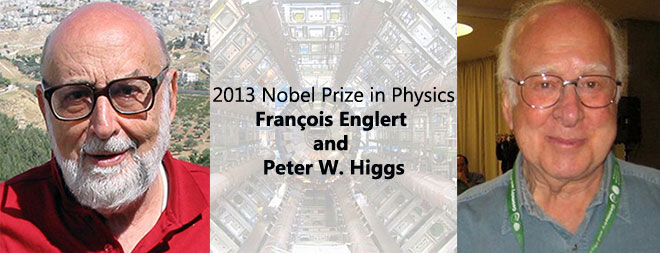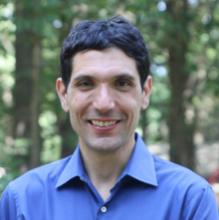Two Physicists Share Nobel Prize For Higgs Discovery

Englert Photo: Pnicolet via Wikimedia Commons | Higgs Photo: G-M Greuel via Wikimedia Commons
(ISNS) -- The 2013 Nobel Prize in physics has been awarded to Belgian scientist François Englert and British scientist Peter W. Higgs "for the theoretical discovery of a mechanism that contributes to our understanding of the origin of mass of subatomic particles, and which recently was confirmed through the discovery of the predicted fundamental particle, by the ATLAS and CMS experiments at CERN's Large Hadron Collider."
In 1964, Englert, with a now-deceased colleague, Robert Brout, and Higgs independently published papers that were able to explain how some subatomic particles, such as electrons and quarks, acquire mass. In their theoretical work, these particles interact with an invisible field in the universe, now known as the Higgs mechanism, to get their mass. On July 4, 2012, two research groups working at the Large Hadron Collider, or LHC, at the CERN laboratory for particle physics in Europe announced compelling evidence for the detection of a particle that would be later confirmed as coming from this invisible field.
“Both [theorists] made a contribution to explaining the origin of mass, and these contributions cannot be distinguished. Now, what they did is essential to the standard model of particle physics,” said Olga Botner, of Uppsala University in Sweden, at the prize announcement.
“It was not a surprise,” said Drew Baden, a physicist at the University of Maryland, in College Park, “and it’s pretty much an amazing story.”
Fifty years ago, physicists faced a huge problem. They knew the universe was made of particles such as electrons, protons and neutrons, which served as the building blocks of matter. These particles were governed by forces, such as electromagnetism, that move these particles around. However, this standard model of particle physics had serious shortcomings. It could not explain why some objects — such as electrons — have mass, and others, such as photons, or particles or light, were massless. In the standard model of 1963, everything would be massless, zooming through the universe at the speed of light. Atoms and molecules wouldn’t be able to form, and stars, planets, galaxies and people wouldn’t be able to exist.
Enter a group of theorists — physicists who aim to describe nature through mathematics — to solve the problem of why certain particles in the universe have mass and others have no mass.
The answer came with the insight that the universe is immersed in fields. For example, the electromagnetic field permeates space and causes positively charged objects to be attracted to negatively charged ones. Electromagnetic forces are exerted between objects through the exchange of photons.
In the 1960s, several theorists independently discovered that they could solve the puzzle of mass in the standard model. Their solution suggested there was another invisible field, now known as the Higgs field. Some particles, such as photons, would be unaffected as they moved through the field. Others, such as electrons, would experience resistance to their motion, or inertia, giving them mass.
“Up until the Higgs was discovered, there was really not a shred of experimental evidence,” said Baden, a physicist who is part of the CMS experimental team at the LHC. Instead, he said, the whole concept came out of a mathematical solution to a problem showing how particles could acquire mass.
Numerous theorists discovered the Higgs solution. First, Englert, with his colleague Brout, published a paper predicting this invisible field. Peter Higgs independently published a paper, which also predicted that a particle, later dubbed the Higgs boson, could pop out of the field, just like photons popping out of the electromagnetic field. Another group of theorists, Gerald Guralnik, C. Richard Hagen, and Tom Kibble, later published a paper also predicting the mechanism independently.
Baden called the prize to Englert and Higgs a “really nice compromise,” along with the acknowledgement of the LHC experimentalists who detected the particle. Englert and Higgs “got the ball rolling” on the idea of an invisible field permeating space, he said.
For decades, the Higgs remained the missing piece of the standard model. It explained why some fundamental particles had mass. But it was incredibly hard to detect. The Higgs particle itself was predicted to have mass. And it was very heavy, much heavier than any fundamental particle yet detected. To remove a particle from the Higgs field required a lot of energy.
It was not until the construction of CERN’s LHC, that physicists could reliably eject Higgs particles from this invisible field. The LHC began operating in 2008.
The LHC accelerates beams of 500 trillion protons — positively charged particles that reside in the cores of atoms — to 99.99999 per cent of light speed, or an energy of 4 teraelectronvolts, or TeV. It’s equivalent to the energy of a runaway train, but concentrated into a ray of subatomic protons. The LHC smashes two such beams together, to create sprays of particles. Einstein’s famous equation, E=mc2, says that energy can be converted into mass and vice versa. From the pure energy of this collision, new particles, different from the initial protons, can emerge.
On July 4, 2012, physicists from two LHC experimental collaborations known as ATLAS and CMS announced they had confirmed the existence of a particle resembling the Higgs. Its mass was approximately 125 gigaelectron volts, or GeV, much heftier than any other fundamental particle, and about 100 times heavier than a proton. In the last year, scientists have confirmed that what they were seeing was the Higgs. Earlier data, from the Fermi National Accelerator Laboratory’s Tevatron accelerator, also provided some evidence for the existence of the particle.
But with the confirmation of the Higgs, the puzzles of the universe are far from solved. While the Higgs may be the last major piece of the standard model, physicists realize that the standard model is still incomplete. For example, it only describes three of the four fundamental forces in the universe, and leaves out gravity.
"In my opinion the most and fundamental problem which is not solved today despite some progress is the problem of quantum gravity, the quantization of gravity," said Englert, while speaking to a press pool immediately following the announcement of the 2013 Nobel Prize.
Englert also said that the questions of supersymmetry, dark matter and dark energy remain mysteries to be solved.
The standard model only describes the ordinary matter in the universe, which now is believed to make up only about a fifth of the known matter in the universe. It doesn’t predict the invisible dark matter or dark energy that in fact, was recognized for a 2011 Nobel Prize in physics.
Peter Higgs was unreachable at the time of the announcement because he is on vacation.
So theorists, and experimentalists alike, are left with lots more questions to answer. Those solutions will likely be worthy of future Nobel Prizes.

